Exploring Molos and at Last Some Goats!
It is a beautiful spring-like day today and I don’t want to waste any of it. Despite feeling like death warmed up I get myself together and go out to explore. I’m curious to see what’s further along the coastline in Molos so I turn left away from the direction of Chora and just follow the asphalt road along. At the supermarket, I take a right and it brings me to a small marina where a couple of fishing boats are moored. The remains of what looks like an old windmill sits on the water’s edge. Looking over to Chora I can just about make out the 200-stepped path that I’d taken the day before. I’m pretty sure that I’d explored a lot of the streets that I could see. There must be much more to Chora than what is currently meeting my eye!
Back on the main road, I continue to follow it around past whitewashed dwellings of all shapes and sizes. There is a lot of accommodation in Molos from quite swish resort-style hotels to simple studios – something for everyone. I must say that architecture is definitely Cycladic in style even down to the detail of the rounded edges on the corners of some of the buildings.
It is really warm today and although my plan was to be in Greece in winter, I think I’ve most definitely missed it. The only indicator that we are indeed still in February is that most of the trees are still bare. There are a few exceptions. The almond trees are in blossom, the citrus trees remain green throughout and spring lambs have already been born. There is an abundance of spring flowers from carpets of bright yellow buttercups to poppies popping up along the wayside.
At the end of this stretch of road, I can see a windmill which sits on the northernmost part of the cape. I Google it quickly and it tells me that this is a cafe bar called Anemomilos. Just to the right of this, I’m thrilled to see the Church of Agios Nikolaos that is built into a large rock formation. I’d read about the church but had no idea whereabouts on the island it was. Aimless wandering can at times lead you to the right places. The rock that houses the church has some natural and some man made recesses which are stuffed full of icons and other various offerings. At the side of the church there is a small annexe about a metre square that has a tiny door at the bottom of it. Just as I approach it a lizard scuttled into it. Surely this isn’t a purposefully made home for lizards? Whatever the reason, the conditions in there must be perfect for them. Adjacent to Agios Nikolaos is the Holy Church of Zoodochos where you can peak through the cut-out cross in the door to see inside.
Just beyond the two churches, a grit track leads me down to some odd looking rock formations and Pouria Beach. As I walk between the crispy scrub I can hear movement all around me. Being the ‘scaredy cat’ that I am, my first go-to thought is snakes. However, as I turn my head towards the sound of the next crackle I can see hordes of lizards darting in all directions. Well if this heat brings the lizards out of hibernation – you know what else likes to warm itself in the heat of the spring sunshine! Just ask my husband about his encounter one April, on the steps to the Church of the Severn Martyrs on Sifnos!!
Just beyond the water’s edge is a small islet with another of the island’s notable churches Agios Ermolaos. It sits in solitude, surrounded by colonies of squawking seagulls. The rock formations along the water’s edge look like the foundations of an archaeological site. However, it’s actually the remains of an ancient quarry. Over time the formations have been carved into steps, terraces and pools. Clambering over the flat rock formations I can see tiny fish that have been trapped inside isolated pools by the outgoing tide and some interesting-looking carvings. One set of carvings appear very pagan – a row of odd-looking beings sitting side by side. Half human, half something else!
This exertion although minor has taken its toll on me. The lurgy is fighting with me and it’s winning. Time to take some action. On my way back to Eleana’s Studios I call in to the supermarket for supplies with lemons and honey at the top of the list. I’m tempted to get some spirit to make a hot toddy but I know that will finish me off for the day. Back at Eleana Studio, hot honey and lemon is made and paracetamols are taken.
Later that afternoon the inaction gets the better of me. I can’t sit still knowing that there may be goat dancers doing their thing in Chora. There is no way on earth I’m going to attempt the 200 steps again especially feeling as grotty as I do. I call Dimitri the taxi driver that had brought me from the airport. It is Dimitri’s sister Frosini that picks me up – they share the taxi business between them.
Frosini drives along the coastal road and then around to the other side of the Kastro where the main part of Chora slowly begins to reveal itself. There are petrol stations and large supermarkets and also a high school. Frosini drops me on the edge of the square which is as far as cars can go. It is only 7€ plus tip up to Chora so a taxi will be the mode of transport from now on.
As I look around it all begins to make sense. When I’d climbed the 200 steps yesterday I had veered to the left whilst following the signs for Kastro. What I should have done is veered to the right and it would have brought me towards Central Square and the heart of the village. Sitting just below this side of the Kastro is the Monastery of St George. I was so close!
The Chora is pretty quiet in the afternoon so now is the time to take a stroll around the streets. One thing is for sure – as far as Chora’s go – this is a pretty special one! The square is surrounded by terraced bars on one side and the City Hall on the other with commemorative statues taking pride of place. Tourist shops sell local produce and of course, goat bells ranging in size from tiny to colossal!
As afternoon fades and early evening descends, the town begins to liven up. Now’s the time to spot some goat dancers!
I always make clear that I’m not a travel writer and never purport to write a travelogue-style blog that tells you everything that you need to know about a place. You can always do a Google and find hundreds of articles that have been first or second-hand researched and spill out the same type of information. However, I do at times feel that I need to give a little bit of background information for context. When blogging and travelling I don’t have much time for research but I will occasionally Google and look for information from those very same travelogue-style blogs. And here is some background on the goat dancing regurgitated in my own words.
Firstly – how did the goat dancing originate? It is said that in ancient times (I may as well say the days of yore!) a goat herder lost his entire flock in a particularly harsh storm. Distraught by the loss of his livelihood and his beloved goats, he mourned their loss by skinning them and cladding himself in their skins. He took the bells from around their necks and tied them to his waist. He then proceeded to parade himself and his misery in the streets of Chora. The local community in sympathy with his loss, have recreated this scene every year ever since. There you go!
Central Square is buzzing as is the main street running alongside it. It isn’t long before I hear the sound clunking goat bells. The ‘clunking’ (I’m not going to use the overused word cacophony) comes in different tones depending on the size and age of the person dressed as the ‘Geros’ (old man). There are children as young as 4, adults and every age in between. They wear a black hooded fur jacket and white leggings wrapped with twine. A goat skin covers their face – said to be from a freshly slaughtered goat. They carry a wooden shepherd’s crook that is held by one end and which they wave and swing in the air. The most interesting part of their wardrobe is the shoes, a type of sandal made from strips of leather wrapped over the foot. It isn’t only the Geros wearing these shoes. Many of the local men are wearing them also. The bells, however, are the most important part of their garb.
The youngest of the Geros wear a belt of small goat bells which make a high pitched ‘clank, clank clank’. An older child, maybe up to a teenager would wear larger bells that make more of a ‘clunk, clunk, clunk’ sound. An adult would wear even more bells but larger ones and their sound would be like a ‘thrump, thrump, thrump’. I’d read that the weight of these bells can be anything from 50-70 kilograms. I wonder if there is an age/size to weight ratio of goat bells?
I notice that the Geros walk with such intent. They lean slightly forward and I wonder if this is to counter-balance the weight of the bells? Anyway, it makes their large stride look purposeful. They will intersperse this with a kick of one leg whilst bending the alternate leg backwards. To really make those bells clang they twist their hips clockwise and anticlockwise which must be the mother of all workouts!
In addition to the role of the Geros is the Korela (girl), played either by a female or man dressed as a female. The white and yellow dress with bell-shaped sleeves is finished off with a yellow and black headscarf and a veil. The Korela leads the Geros along the street, dancing and spinning and waving a white handkerchief in the air with one hand behind her back.
There are also other characters in the mix. There is the Frango or fool that can be dressed as anything – the more ludicrous the better. One character this evening is that of the priest which is associated with one of the most contentious issues affecting Skyros and its residents. Several years ago a priest sold a chunk of land for wind farm development. It is obvious from the variety of posters that are hanging in several of the shop windows that the Skyriots are most definitely opposed to the wind farm. The priest now features as the Frango as part of the festival. I think that I’ve just received a special blessing from him!
Up and down the street the Geros, Korela and the Frango parade. I was so impressed by the children who executed their duty with such determination and diligence. No complaints about the weight of the bells or the repetitive nature of the ritual. I just couldn’t see any of my grandchildren doing the same without moaning that they were tired or the bells were too heavy. Well done children of Skyros – you have been fantastic!
As the festivities begin to calm, I take the opportunity to get something to eat. There is a really good souvlaki place on the main street called Mantzourana. As grilled chicken goes this is really excellent.
I call it a night and call Dimitri to take me back to the studios. I need to top up with some lemon and honey.

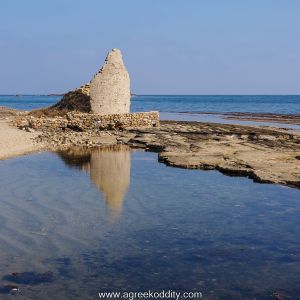
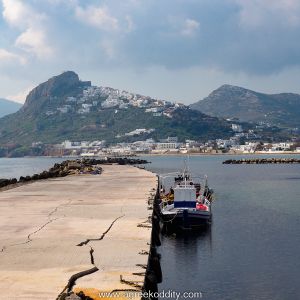
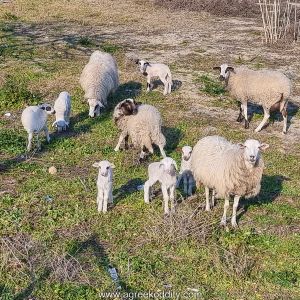
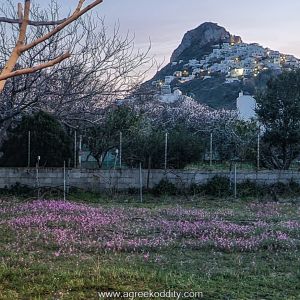
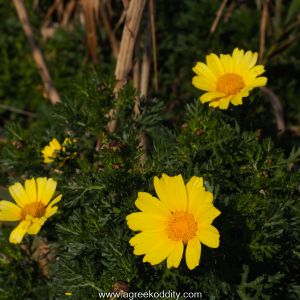




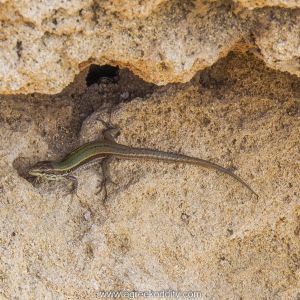
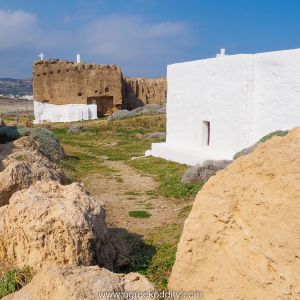

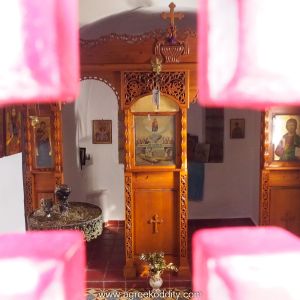


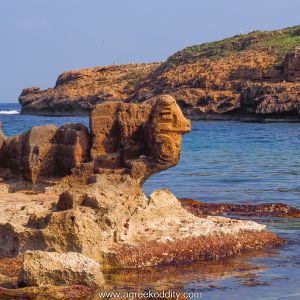
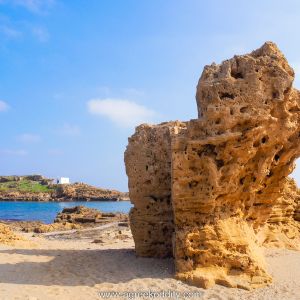
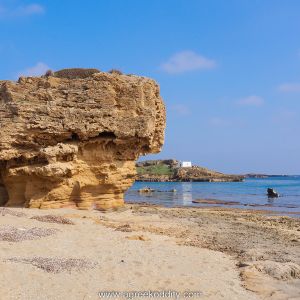
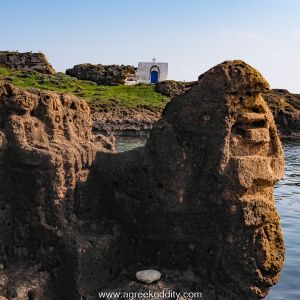
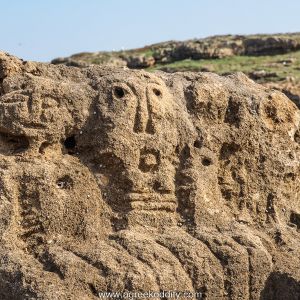
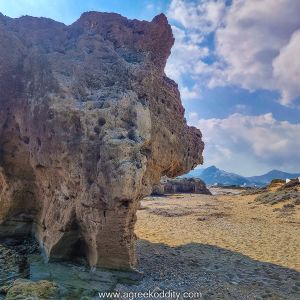
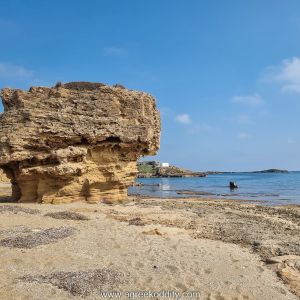


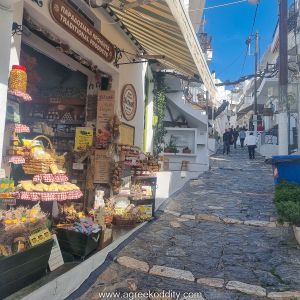
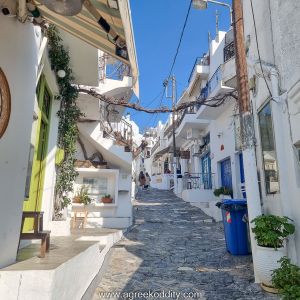

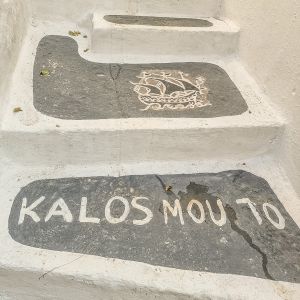
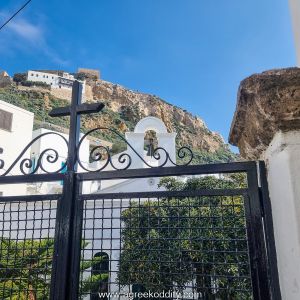
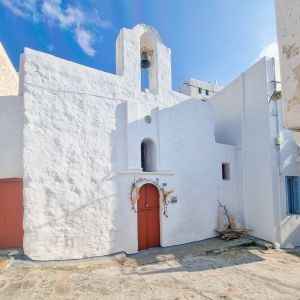
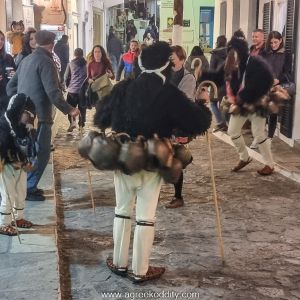
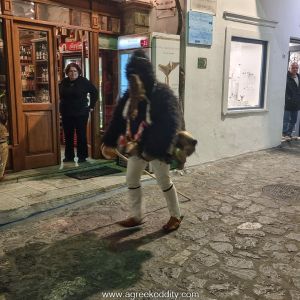



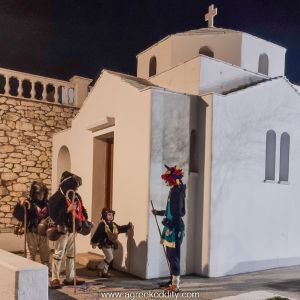

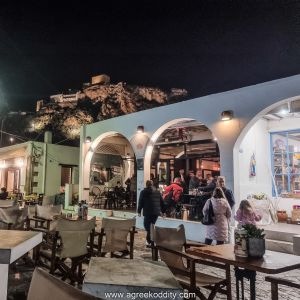

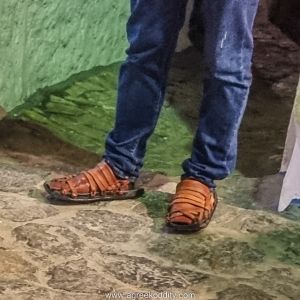
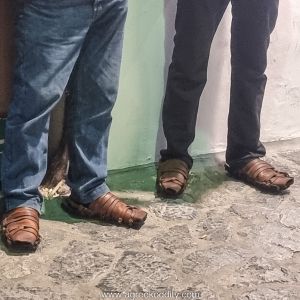








Hi Stephanie, what a bizarre festival! I love the little ones with their cow bells, and you did indeed get “blessed!” Hope your cold cleared up quickly, no fun being sick when travelling.
Cheers, Pat
Hi Pat. Yes it is the most unique festival that I’ve seen in Greece. I’m sure there are many others like this waiting to be discovered. Thank you for your kind thoughts. I’m now on antibiotics so hopefully that will put an end to the lurgy!
I love seeing how the Greeks keep their traditions going and pass everything down the generations- its what makes the country so special !
It surely is Liz! It’s good to discover Greece in winter too because all kinds of little gems are revealed!